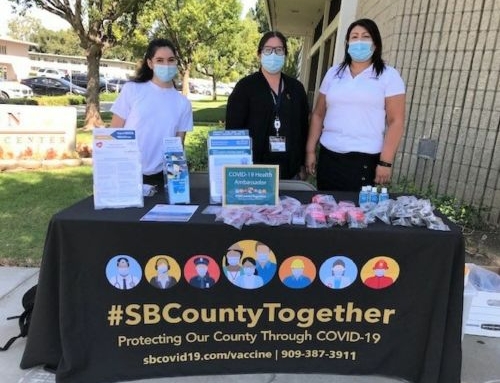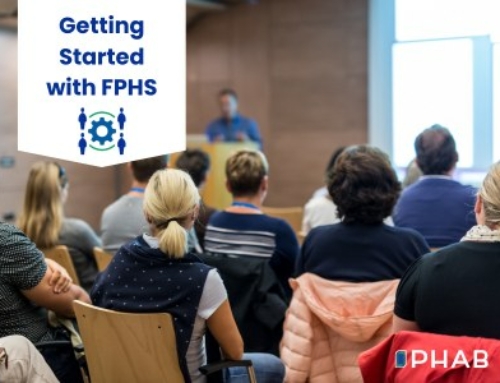One important characteristic of public health innovation is that a developed process, policy, product, or program lends itself to adaptation/adoption, replication, and diffusion. As the public health landscape shifts around us, health departments are implementing innovative practices to help meet the needs of their communities, address the social determinants of health, and achieve a culture of health.
With support from the Robert Wood Johnson Foundation, and in collaboration with the Garrett County Health Department (GCHD), PHNCI has awarded innovation replication grants to five health departments to develop and implement the Universal Community Planning Tool (UCPT) in their own communities. The UCPT is an innovative digital collaboration platform that is revolutionizing the way communities develop their comprehensive health improvement plans. GCHD is helping guide awardees through the installation and implementation of the tool to test the utility of the UCPT in various settings, and to inform potential widespread use by the public health community. The five, accredited health department awardees are:
- Allegany County Health Department (MD)
- Clackamas County Public Health (OR)
- District of Columbia Department of Health
- Flathead City-County Health Department (MT)
- Medina County Health Department (OH)
In this blog, we hear from each pilot site as they installed, built, launched, and oriented stakeholders to their unique UCPT.
Choosing the UCPT
- Allegany County Health Department – We identified the need to improve community engagement in the health planning process at the same time we observed Garrett County’s success with their platform. We also recognized the value the UCPT has in supporting our efforts at reaccreditation by the Public Health Accreditation Board (PHAB).
- Clackamas County Public Health – We chose to apply for the opportunity to implement the UCPT to increase transparency and accountability in our community health improvement plan (CHIP) implementation process. We also thought it would be an invaluable tool to reach the more rural constituents of our county and have a better understanding of who is involved in the process.
- District of Columbia Department of Health – We had already heard about and been interested in the tool, but the learning curve seemed a bit high and competing priorities didn’t allow us to focus on it as we would have liked. We were most interested in the technical assistance and being part of a learning community provided by the grant opportunity in order to provide a platform that could support both collective impact projects across the city as well as increase resident-level engagement in our community health improvement process.
- Flathead City-County Health Department – We became accredited by PHAB in 2016, and since we began the community health assessment (CHA)/CHIP process 7 years ago, we have been continuously looking for ways to increase meaningful community engagement beyond our traditional partners. We see the UCPT as an opportunity to create a platform for all our stakeholders to increase visibility, and to connect the dots of how social determinants of overlap all the work we do.
- Medina County Health Department – We saw the UCPT as a way to turn our CHIP outward from a small group of agencies to a project inclusive of our full community.
Installing the UCPT
- Allegany County Health Department – It was intimidating since our lead staff does not have any background in web design nor fluency in the language surrounding the technological aspects of the project. We initially felt like we were getting too far into something we were not fit to do, but in time, and with patient guidance from GCHD, we were able to tackle the challenge.
- Clackamas County Public Health – The UCPT installation process was difficult for two reasons – we didn’t understand the technology of private/cloud servers and our technology services department was resistant to the idea regardless of where it was hosted. They were resistant to host the website on internal servers for security reasons. They were hesitant to let us host it on an external server because then they would be unable to help us with upkeep and maintenance.
- District of Columbia Department of Health – The UCPT installation process itself was very straightforward. Organizing the supporting plug-ins and design elements, to get the entire website where we wanted it to be, was a bit heavier of a lift. The technical assistance provided was invaluable during this time.
- Flathead City-County Health Department – We have been fortunate to have great support from our IT department and worked closely with them to develop our site. With that being said, installation was very easy to complete. Our IT had no issues on the initial UCPT or the updated UCPT just released.
- Medina County Health Department – The process was challenging, but we were a pilot test to see what types of guides, tutorials, and technical assistance the average health department would need to be able to launch this tool.
Building the UCPT
- Allegany County Health Department – Hyper-local data collection within action groups was the most important to have right from the start. We were also happy to utilize survey tools from the start and look forward to pushing out more. Although we have not been able to add this yet, we would like to add some gamification, and some sort of layer of announcements or highlights, which might draw more people in.
- Clackamas County Public Health – Honestly, they’ve all been very important as we market the tool. The usability and versatility of the tool is one way we’ve been able to sell it to partners. What seem to be the most important at this point are the community forum, action groups, data collection page, google docs, and documents capability.
- District of Columbia Department of Health – The most important feature for us, that seemed unique to other pilot sites, was the ability to track performance indicators related to specific actions/interventions. In addition, we also planned to use the action groups in several ways: to organize multisector stakeholders to share resources and participate in virtual discussions, and to engage residents in topic-area discussions to inform our community health improvement process. Finally, the ability to tag and pull reports was an important feature for us.
- Flathead City-County Health Department – We think all the features of the UCPT were created with such intention and see value in the entire platform. The UCPT provides support to groups regardless of where they fall in the planning process. The ability to work within action groups in an online digital platform is for us the best feature.
- Medina County Health Department – We spent a good deal of time on the feel of the landing page and the ease of sign-up. We wanted our UCPT to be unlike any of our partner agency websites, and we wanted the public to feel welcome and confident using it.
Launching the UCPT
- Allegany County Health Department – We promoted on Facebook, Twitter, and on conventional radio (interviews and ads), online newspaper ads, and billboards. We “soft-launched” to the health department staff initially, and then we increased exposure stepwise to the stakeholder agencies next. Finally, we were full on public. All this was within one week.
- Clackamas County Public Health – At the moment, our UCPT tool is marketed to those who were involved in the CHIP planning process and those who are interested in applying for a CHIP grant. We are also engaging internal partners to create action groups (so far, we have engaged infectious disease, opioids, and emergency preparedness) for community education. We have a larger global marketing plan (including Facebook/Instagram ads, community outreach, and incentives) planned for later this fall/winter once we integrate our own data platform into the tool and domain name.
- District of Columbia Department of Health – The rollout of our tool began with a soft launch. We engaged partners we already work closely with via meetings and emails, as well as a promotional email from our Director to our Health Department staff. The full launch included a social media campaign, distribution of posters and postcards with partners and at events, and continued outreach to the larger community via emails. We will be using branded swag to continue to promote and incentivize participation in the future.
- Flathead City-County Health Department – Our marketing and launch plans included four aspects. To foster leadership and management buy in, we worked closely with the Deputy Health Officer during this process. We presented to the management team at our Health Department within weeks of returning from in person training. We wanted to start at the top with our organization. We designed 6 logos and had our staff and community vote on the logos in the lobby of our health department. We had over 300 total votes. This was a fun interactive way to roll out the UCPT to our organization and greater community. We have presented at several community groups talking about the UCPT. We have limited marketing materials but with a functional site, an awesome logo and business cards we have been very successful at on-boarding community members. We haven’t started social media or email campaigns but see those coming soon!
- Medina County Health Department – Our launch to the public is involving community groups with data driven projects and/or those who have expressed a desire to promote their efforts more broadly. We are looking to guide their development of a UCPT group and thus build the broadest appeal to the public with a wide range of UCPT topics. We have also considered gamification as a way to promote ongoing use.
Orienting Partners and the Community
- Allegany County Health Department – We have been speaking and demonstrating the UCPT individually, and at stakeholder meetings. We have reached out to the local community college who seems very interested, and we hope to see their involvement soon. We ran into some barriers to full participation with some partners; we still have a lot of work to do to reach other stakeholders, and we are limited by the time we have to dedicate to the project.
- Clackamas County Public Health – Partners were oriented to the UCPT by sitting with them and helping while they create an action group. Community members, thus far, have been oriented to the UCPT by email invitations to join a particular group. We have had great success of community members joining the group they were invited to join, plus other action groups that they noticed once on the site. There has been a lot of handholding and technical assistance necessary for some community members, but the process seems to have smoothed considerably since we removed email verifications from the registration process.
- District of Columbia Department of Health – Our strategic plan included bilateral outreach to partners and community-based organizations to brief them on the purpose and logistics of the tool. We led tutorial sessions and developed a tutorial page on the website to show prospective registrants how to sign-up and create groups. We reached out to partners and requested time on meeting agendas to orient and pitch their respective networks on ways they could incorporate the tool in their workflows/organizing.
- Flathead City-County Health Department – We’ve done several community presentations introducing our community to our UCPT. We often invite community members to grab their phones and register for the site while we are in the room. We also make sure to provide our contact information to groups, so they can follow up with us. We’ve had success meeting with community groups individually to help with on-boarding and building community action groups. This practice helps us to build stronger relationships and provides them with an opportunity to ask questions and learn more about the UCPT.
- Medina County Health Department – We used our CHIP action team chairs to become early champions and then we rolled the UCPT out to both active and passive CHIP members. Those teams are loading data and beginning to attach documents within their UCPT groups.
Next Steps
Q&A conducted, edited, and condensed by Travis Parker Lee, Program Specialist. PHNCI thanks the following people for their contributions to this blog post:
- Jennifer Corder, Allegany County Health Department
- Anna Menon, Clackamas County Public Health
- Emily Putzer and Alyzza Dill-Hudson, District of Columbia Department of Health
- Molly Neu and Heather Murray, Flathead City-County Health Department
- Krista Wasowski, Medina County Health Department





